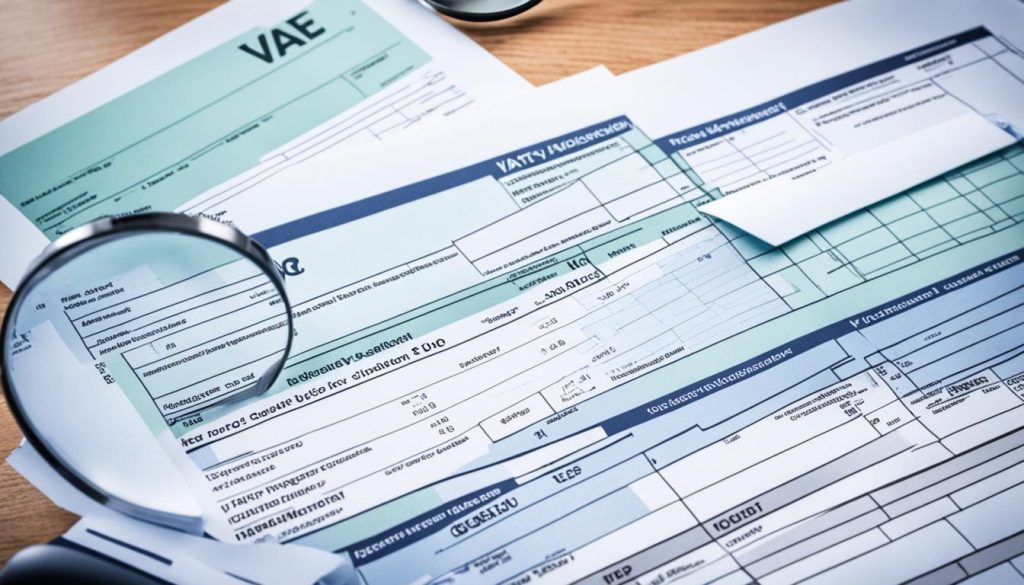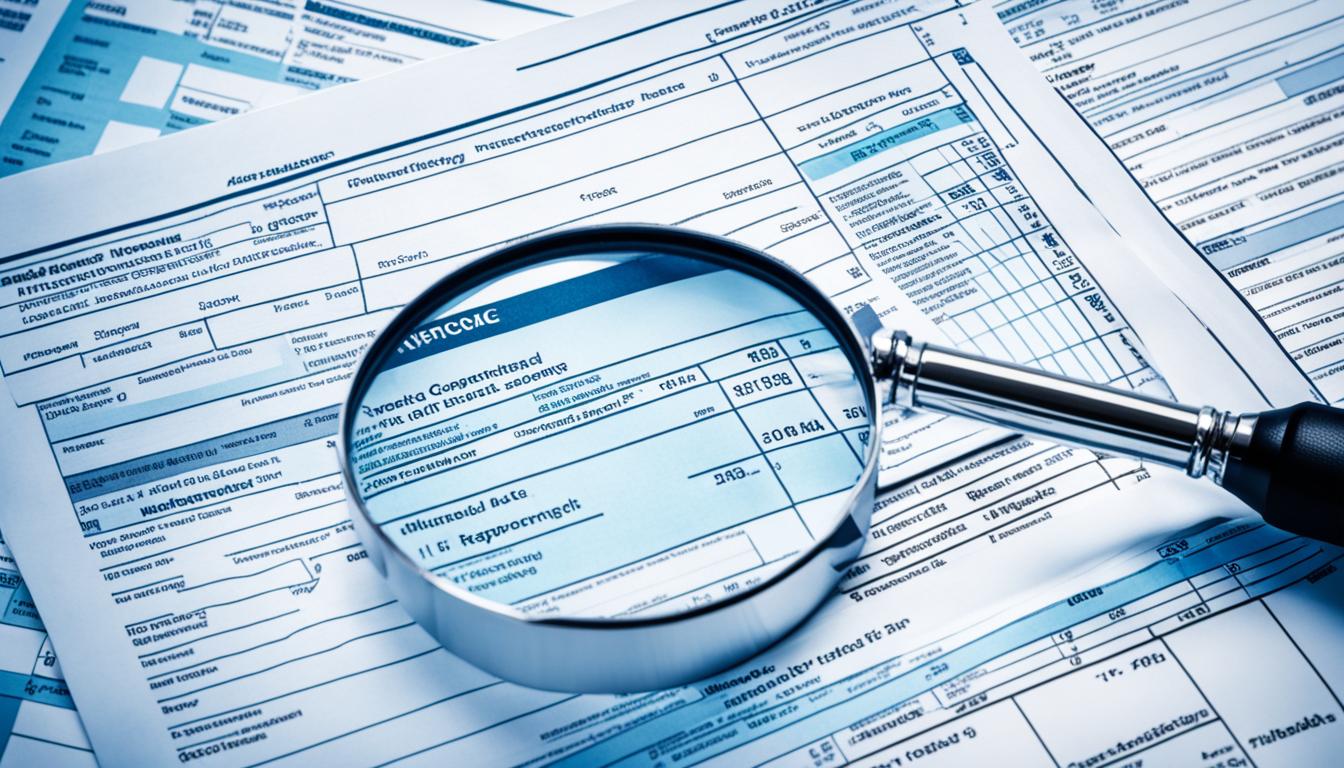Welcome to our comprehensive guide on HMRC VAT invoice requirements in the UK. Understanding these requirements is crucial for businesses registered for VAT, as non-compliance can result in penalties and disruptions to your operations. This guide aims to provide you with a deep understanding of the VAT invoice requirements set by HMRC, ensuring that you stay compliant and avoid any potential issues.
Understanding VAT Invoices
A VAT invoice is an important document for businesses registered for VAT. It is used to record and document transactions involving the supply of goods or services and helps both buyers and sellers manage their VAT obligations.
The format and layout of a VAT invoice may vary, but there are certain key elements that must be included according to HMRC guidelines. These elements ensure that the invoice is complete and compliant with VAT regulations.
Format and Layout of a VAT Invoice
A typical VAT invoice includes the following details:
- Unique Invoice Number: Each VAT invoice must have a unique identification number to differentiate it from other invoices.
- Date of Issue: This is the date when the invoice is issued to the buyer.
- Seller’s Information: The VAT-registered seller’s name, address, and VAT registration number must be clearly stated on the invoice.
- Buyer’s Information: The buyer’s name, address, and VAT registration number (if applicable) should also be included.
- Description of Goods or Services: A clear and detailed description of the goods or services supplied must be provided.
- Quantity and Unit Price: The quantity of goods or services and the unit price should be specified in the invoice.
- VAT Rate and Amount: The applicable VAT rate and the amount of VAT charged should be clearly stated.
- Total Amount: The total amount payable, including VAT, should be calculated and displayed.
It is important to ensure that the VAT invoice accurately reflects the transaction and includes all the necessary details. Failure to do so may result in non-compliance and potential penalties from HMRC.
The image above shows an example of a VAT invoice format. It provides a visual representation of the layout and the key elements that need to be included.
By understanding the format and layout of a VAT invoice, businesses can ensure that they meet the necessary requirements and maintain accurate records for VAT purposes.
VAT Invoice Requirements in the UK
When it comes to VAT invoice requirements in the UK, it’s essential for businesses to understand the specific guidelines set by the HMRC. These requirements ensure that VAT invoices are accurate, compliant, and serve as valid supporting documentation for tax purposes.
Below, we outline the mandatory information that must be included on a VAT invoice:
| Information | Description |
|---|---|
| 1. Unique Identification Number | A VAT invoice must have a unique identification number that helps in identifying and tracking the invoice. |
| 2. Seller and Buyer Details | The VAT invoice must clearly state the seller’s name, address, and VAT registration number, as well as the buyer’s name and address. |
| 3. Description of Goods or Services | It is essential to provide a clear description of the goods or services provided in the invoice. |
| 4. VAT Amount | The VAT amount charged for the goods or services must be clearly specified on the invoice. |
In addition to these mandatory requirements, there may be specific additional requirements for VAT invoices issued by retailers or businesses other than retailers. It’s crucial for businesses to understand and adhere to these requirements to ensure compliance with HMRC regulations.
Creating VAT invoices that meet all the necessary requirements is essential for businesses registered for VAT. By doing so, businesses can avoid penalties and maintain accurate records for tax purposes. It’s important to stay up-to-date with any changes in VAT invoice regulations to ensure compliance with the latest guidelines set by the HMRC.
Example:
Here’s an example of a properly formatted VAT invoice:
“` Invoice Number: INV-2021-001 Date: 1st September 2021
Seller’s Details: ABC Company Ltd
123 Main Street
London
VAT Registration Number: GB123456789
Buyer’s Details: XYZ Corporation
456 High Street
Manchester
Description of Goods/Services: – 5 units of Product A
– 3 hours of Service B
Subtotal (excluding VAT): £500 VAT (20%): £100 Total: £600
“`
By ensuring that your VAT invoices adhere to the specified requirements, you can confidently manage your VAT transactions and maintain proper records for tax purposes.

Mandatory Information for VAT Invoices
When it comes to VAT invoices, including the mandatory information is crucial for businesses to comply with HMRC regulations. Failure to include this information may result in penalties or rejection of the invoice. In this section, we will outline the essential details that must be included on a VAT invoice to ensure compliance and facilitate smooth business transactions.
1. Unique Identification Number
Every VAT invoice should have a unique identification number. This number helps in differentiating each invoice and is useful for tracking purposes, especially when dealing with large volumes of invoices.
2. Seller and Buyer Details
Both the seller and buyer information must be clearly stated on the VAT invoice. This includes their legal names, addresses, and VAT registration numbers (if applicable). Providing accurate and complete contact details is essential for record-keeping and communication purposes.
3. Date of Supply
The date of supply refers to the date when the goods were delivered or the services were performed. It is necessary to include this date on the VAT invoice to determine the correct VAT rate and tax period for the transaction.
4. Description of Goods or Services
A detailed and accurate description of the goods or services provided is essential on a VAT invoice. This description should be clear and informative, enabling the recipient to quickly identify the nature of the transaction.
5. VAT Amount
The VAT amount charged for the goods or services must be clearly stated on the invoice. This includes both the VAT rate applied and the VAT amount calculated for each line item.
6. Total Amount Payable
The total amount payable, including VAT, should be clearly specified on the invoice. This amount is the sum of the net value of the goods or services and the VAT amount charged.
7. Additional Requirements
In certain cases, there may be specific additional requirements for VAT invoices issued to EU member states or under certain schemes. It is crucial to review the HMRC guidelines or seek professional advice to ensure compliance with any unique requirements.
By incorporating all the mandatory information on VAT invoices, businesses can maintain accurate records, facilitate efficient financial processes, and comply with HMRC regulations. Failure to include any essential details may result in non-compliance issues and delays in VAT reclaim processes. Refer to the table below for a summarized list of the mandatory information for VAT invoices.
| Mandatory Information for VAT Invoices |
|---|
| Unique Identification Number |
| Seller and Buyer Details |
| Date of Supply |
| Description of Goods or Services |
| VAT Amount |
| Total Amount Payable |
Now that we have covered the mandatory information for VAT invoices, let’s move on to Section 5 to explore the format and layout of VAT invoices and provide examples of different invoice formats.

VAT Invoice Format and Layout
Creating a VAT invoice involves understanding the proper format and layout to ensure compliance with HMRC requirements. In this section, we will explore different invoice formats and provide examples of both paper and electronic invoicing. We will also discuss the use of templates and software to simplify the process and ensure accuracy.
Examples of VAT Invoice Formats
When it comes to VAT invoice formats, businesses have options that cater to their specific needs. Let’s take a look at a few examples:
| Paper Invoice | Electronic Invoice |
|---|---|
| Traditional paper invoices are still widely used by many businesses. They are printed on company letterhead and sent to customers via mail or in-person. | Electronic invoices are generated and sent electronically, either as a PDF attachment via email or through an online invoicing platform. They offer convenience and speed, reducing both costs and paperwork. |
Regardless of the format, VAT invoices must include specific details outlined by HMRC.
Utilizing Templates and Software
To simplify the process of creating VAT invoices, businesses can utilize templates and software designed specifically for this purpose. These tools provide preformatted templates that include all the necessary information required by HMRC. By inputting the relevant details, such as seller and buyer information, description of goods or services, VAT amount, and unique identification number, businesses can generate professional VAT invoices quickly and efficiently.
Using templates and software not only ensures compliance but also minimizes the risk of errors and omissions, saving valuable time and effort. It also allows for consistency in invoice layout and branding, which can enhance a business’s professional image.

With the right VAT invoice format and layout, businesses can confidently issue invoices that meet HMRC requirements while streamlining their invoicing processes. Whether opting for traditional paper invoices or embracing electronic invoicing, utilizing templates and software can simplify the creation of VAT invoices and contribute to accurate and efficient record-keeping.
Common Mistakes to Avoid in VAT Invoices
When it comes to VAT invoicing, it’s crucial for businesses to avoid common mistakes that could lead to non-compliance with HMRC regulations. In this section, we’ll highlight some of the most frequently made errors and provide you with a comprehensive checklist of essential elements to include on a VAT invoice. By following this checklist and being mindful of these common mistakes, you can ensure accurate and complete invoicing for VAT purposes.
Mistake #1: Incomplete Identification Information
One of the most common errors in VAT invoices is failing to include complete identification information for both the seller and the buyer. To avoid this mistake, make sure to include the legal name, address, and VAT registration number of both parties. This ensures that the invoice is properly attributed to the correct entities and helps prevent any confusion or disputes.
Mistake #2: Incorrect Description of Goods or Services
Another common mistake is inaccurately describing the goods or services being invoiced. It’s important to provide a clear and detailed description that accurately reflects what was provided. This helps HMRC assess the correct VAT treatment and ensures transparency in the transaction.
Mistake #3: Missing or Inaccurate VAT Amount
Avoiding errors in calculating and including the VAT amount is crucial for VAT invoicing. It’s essential to accurately calculate the VAT due and clearly state the amount on the invoice. Failure to include the correct VAT amount or providing inaccurate calculations can lead to errors in VAT reporting and potential penalties.
These are just a few examples of common mistakes to avoid in VAT invoices. To help you ensure compliance and accuracy in your VAT invoicing, we’ve prepared a comprehensive checklist of essential elements to include:
| Essential Elements |
|---|
| Seller’s legal name, address, and VAT registration number |
| Buyer’s legal name, address, and VAT registration number (if applicable) |
| Date of the invoice |
| Unique invoice number |
| Clear and accurate description of goods or services |
| Quantity of goods or services provided |
| Price per unit (excluding VAT) |
| Total amount payable (excluding VAT) |
| VAT rate applied |
| Total VAT amount payable |
| Total amount payable (including VAT) |
By following this checklist and avoiding these common mistakes, you can ensure compliance with HMRC regulations and reduce the risk of errors and penalties in your VAT invoicing. Remember, accurate and complete invoicing is not only essential for VAT purposes but also for maintaining good financial records and building trust with your customers.

Importance of Proper VAT Invoicing
Proper VAT invoicing is essential for businesses that are registered for VAT and want to maintain compliance with HMRC regulations. Accurate record-keeping and invoicing practices not only ensure smooth business operations but also help to avoid potential penalties and legal issues. Let’s explore why proper VAT invoicing is of utmost importance:
1. Compliance with HMRC Regulations
Proper VAT invoicing is crucial for businesses to comply with HMRC regulations. By issuing VAT invoices that meet the required standards, businesses can avoid unnecessary audits and penalties. Compliance with VAT invoicing requirements demonstrates transparency and builds trust with HMRC, reducing the risk of investigations or disputes.
2. Accurate Record-Keeping
VAT invoices serve as essential documentation for financial and tax purposes. By maintaining proper VAT invoicing practices, businesses can accurately track their sales, purchases, and VAT liabilities. This ensures accurate financial reporting and facilitates smooth tax filings, preventing errors and discrepancies that could potentially attract unwanted attention from tax authorities.
3. Streamlined VAT Reclaim Process
VAT invoices play a crucial role in the VAT reclaim process. When businesses purchase goods or services, proper VAT invoices enable them to reclaim the VAT they have paid from HMRC. Without appropriate invoices, businesses risk losing out on potential VAT reclaims, leading to financial losses. By adhering to VAT invoicing requirements, businesses can ensure they have the necessary documentation to support their VAT reclaims.
4. Enhanced Professionalism
Proper VAT invoicing reflects a professional approach to business operations. It demonstrates that a business values accuracy, transparency, and compliance. By providing VAT invoices that meet the required standards, businesses enhance their reputation with customers, suppliers, and other stakeholders. This helps to build trust and credibility in the marketplace, potentially leading to stronger business relationships and increased customer loyalty.
5. VAT Invoice Compliance Checklist
To assist businesses in meeting the necessary VAT invoicing requirements, we have created a handy VAT invoice compliance checklist. This checklist outlines the mandatory information that must be included on a VAT invoice, such as the unique identification number, seller and buyer details, description of goods or services, VAT amount, and more. By using this checklist, businesses can ensure they are meeting all the necessary requirements and avoid any potential issues with HMRC.
Proper VAT invoicing not only ensures compliance with HMRC regulations but also helps businesses maintain accurate records, streamline the VAT reclaim process, enhance professionalism, and strengthen relationships with stakeholders. By following the VAT invoice compliance checklist, businesses can ensure they are meeting all the necessary requirements and setting a solid foundation for successful VAT management.
VAT Invoice Vs. Standard Invoice: Key Differences
When it comes to invoicing, there are different types that businesses use, such as VAT invoices and standard invoices. Understanding the differences between these two types of invoices and the legal requirements surrounding them is crucial for businesses in the UK.
What is Legally Required on an Invoice in the UK?
In the UK, there are legal requirements that must be met when issuing invoices, regardless of whether it is a VAT invoice or a standard invoice. These requirements are outlined by HMRC (Her Majesty’s Revenue and Customs) to ensure compliance and accurate record-keeping.
These legal requirements include:
- The word “Invoice” clearly stated on the document
- A unique invoice number to identify and track each invoice
- The seller’s and buyer’s legal names and addresses
- The date of the invoice
- A description of the goods or services provided
- The price per unit, quantity, and total amount
- The amount of VAT charged, if applicable
- If VAT registered, the seller’s VAT registration number
It is important to note that these requirements apply to both VAT invoices and standard invoices.
Key Differences Between VAT Invoices and Standard Invoices
While both VAT invoices and standard invoices share common legal requirements, there are specific differences that set them apart:
- VAT Registration: VAT invoices are issued by businesses registered for VAT, whereas standard invoices can be issued by all businesses, whether they are registered for VAT or not.
- VAT Information: VAT invoices contain additional information related to VAT, such as the VAT registration number of the seller, the amount of VAT charged on each item, and the total VAT amount. Standard invoices do not include this VAT-specific information.
- VAT Reclaim: VAT invoices are necessary for businesses to reclaim VAT, while standard invoices do not serve this purpose.
Are There Legal Requirements for Invoices?
Yes, there are legal requirements for invoices in the UK, as mentioned earlier. These requirements exist to ensure accurate information, proper VAT calculation, and compliance with HMRC regulations. Failure to meet these legal requirements can result in penalties and complications with tax reporting.
It is essential for businesses to understand these requirements and ensure that their invoices, whether VAT or standard, meet all the necessary criteria for legality and compliance.
Who Needs to Issue VAT Invoices?
When it comes to VAT invoices, it’s crucial to understand who is required to issue them in the UK. This helps businesses ensure compliance with HMRC regulations and maintain proper record-keeping. But is it a legal requirement to provide a VAT invoice? Let’s find out.
Legal Requirement to Provide a VAT Invoice
Yes, it is a legal requirement for VAT-registered businesses to provide a VAT invoice to their customers. This applies to businesses that are registered for VAT purposes and are making taxable supplies of goods or services. Issuing a VAT invoice allows businesses to provide a transparent breakdown of the VAT charged.
By providing a VAT invoice, businesses demonstrate their compliance with the VAT laws and regulations set by HMRC. This helps in creating a paper trail and ensuring transparency in business transactions.
Exceptions or Exemptions
While issuing a VAT invoice is generally a legal requirement, there are a few exceptions to keep in mind. The following scenarios do not require the issuance of a VAT invoice:
- When your customer is not registered for VAT
- When your customer is registered for VAT but is not making taxable supplies
- When selling goods or services that are outside the scope of VAT
It’s important to note that these exceptions apply under specific circumstances, and it is advisable to seek professional advice if you are unsure whether a VAT invoice is necessary in a particular scenario.
Importance of VAT Invoices for Reclaiming VAT
VAT invoices play a crucial role in reclaiming VAT for businesses. When it comes to input tax, which is VAT paid on purchases made for business purposes, businesses can typically reclaim VAT by including it in their VAT returns. However, to support the reclaim process, businesses must provide valid VAT invoices.
A valid VAT invoice ensures that the VAT claimed is legitimate and provides necessary details required by HMRC. It also acts as evidence for input tax and helps in avoiding any potential issues during VAT audits or inspections.
Implications of Not Providing a VAT Invoice
Not providing a VAT invoice when required can have implications for both businesses and customers. For businesses, failing to issue a VAT invoice may result in non-compliance with HMRC regulations and can lead to penalties or fines. It can also hinder the reclaiming of VAT on purchases.
Additionally, not receiving a VAT invoice can be inconvenient for customers who may need the invoice for their own record-keeping or VAT reclaims. It is always recommended to provide a VAT invoice to maintain transparency and ensure smooth business transactions.
| Key Points | |
|---|---|
| Issuing a VAT invoice is a legal requirement for VAT-registered businesses. | ✅ |
| There are exceptions where a VAT invoice may not be required. | 🛇 |
| VAT invoices are essential for reclaiming VAT. | 💼 |
| Failure to provide a VAT invoice may lead to penalties and fines. | ⚠️ |
Conclusion
Throughout this guide, we have explored the VAT invoice requirements in the UK and the importance of adhering to them. By understanding the criteria, guidelines, and standards for VAT invoices, businesses can ensure compliance with HMRC regulations and avoid potential consequences.
A VAT invoice must include specific information such as the seller and buyer details, a unique identification number, a description of goods or services, and the VAT amount. Furthermore, it is not mandatory to include the customer’s VAT number on the invoice, but it is advisable to do so for record-keeping purposes.
To meet the invoicing requirements for VAT, businesses must provide accurate and complete information on a valid tax invoice. By doing so, they can maintain proper records, claim VAT refunds, and demonstrate compliance with the law.
Proper invoicing practices also benefit businesses by ensuring smooth financial transactions, improving customer relations, and facilitating efficient accounting processes. Therefore, it is crucial for businesses to familiarize themselves with the legally required information on invoices and implement robust invoicing procedures.
FAQs
Do you have to put customers VAT number on invoice?
While it’s not always mandatory to include a customer’s VAT number on an invoice, doing so can be beneficial for both parties, especially in business-to-business transactions. If your customer is VAT registered, including their VAT number can help streamline their input tax recovery process.
What is a VAT invoice UK?
A VAT invoice in the UK is a document provided by a VAT-registered seller to a customer, detailing the goods or services supplied, along with the applicable VAT amount. It serves as evidence of the transaction and enables the recipient to reclaim any VAT charged if they are also VAT registered.
What is required on a VAT valid tax invoice?
A valid VAT invoice in the UK must include specific details such as the seller’s and buyer’s names and addresses, invoice number, date, description of goods or services, quantity, unit price, total amount, and the amount of VAT charged at each rate.
Who must issue a VAT invoice?
VAT-registered businesses in the UK are required to issue VAT invoices to other VAT-registered businesses or individuals when providing taxable goods or services. Issuing correct VAT invoices is essential for compliance with HMRC regulations.
What is the minimum requirements of a tax invoice?
The minimum requirements for a tax invoice typically include the seller’s details, buyer’s details, invoice number, date of issuance, description of goods or services, total amount due, and any applicable taxes, such as VAT, if relevant.
Is it illegal not to provide a VAT invoice?
Failure to provide a VAT invoice when required can result in penalties or fines from tax authorities. It is advisable to issue VAT invoices promptly and accurately to ensure compliance with tax regulations.
What is the 30-day rule for VAT invoices?
The 30-day rule for VAT invoices states that businesses must issue a VAT invoice within 30 days of the date of supply of goods or services. Prompt invoicing is crucial for accurate accounting and compliance with tax regulations.
What is mandatory on an invoice?
Mandatory details on an invoice typically include the seller’s information, buyer’s information, a unique invoice number, invoice date, description of goods or services, quantity, price, total amount due, and any applicable taxes such as VAT. Providing clear and complete invoicing details is essential for legal and financial purposes.





